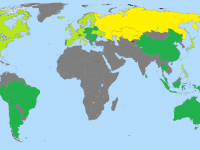Embodied fiction has an annoying habit of taking on a life of its own. Real events in larp surge into fictional constructs like waves on a beach, altering its surface. Why then do we need to separate fiction and reality in our larp theory? Larp has been re-framed a number of times since its proper inception in the early 1980s: as a medium of pure escapism, as an artform, as a powerful means of immersion, as a form of interaction design. My goal here is to re-frame it yet again, this time in terms of a theory that combines narrative and play, in-game and out-of-game experiences.
Despite decades of talking about tensions between larp narratives and larp experiences, we remain dissatisfied with our theory on the topic. Larpwright Juhana Pettersson (2017) recently posed the question: “What do we mean when we talk about story in larp? … [The] concepts we have for talking about the experience of story are weak” (83-84). The aesthetic framework for us to address what designers and players witness as the “experience of story” requires further articulation, which this essay provides. Specifically, it dwells on three ritualistic concepts: emergence, iteration, and reincorporation.[1]Almost immediately, one is prompted to think of studies of religious rituals. Indeed, there is a productive framework to be found in larps as rites of passage. Victor Turner, referring to Arnold van Gennep, talks of rites of passage as being divided into “separation, transition, and incorporation.” There is not space here to delve into ritual theory, but this author confesses that, indeed, a pregnant relation between narrative, ritual, and larp does indeed persist.
Theorists and practitioners of role-play often use the verb “emerge” to describe what happens to both narrative and player activity during a game: that the larp design elements and player embodiment enable the emergence (McGonigal 2003) of a thing both not wholly unexpected and nevertheless intensely engaging. Yet this basic synthesis itself remains underexamined. We use the verb “emerge” and the adjective “emergent” as though these were natural processes, rather than carefully cultivated within the design. Furthermore, the spontaneity of emergence in larp remains in dialogue with its counterpart: iteration, or the rhythmic repetition and slight variation of the same element throughout a game. Iteration permits the emergent content to interact productively with the intended themes of the larp. Finally, one can attribute much of the emotional impact of a given game or campaign when an emergent or iterative element from a previous part of a larp returns in a transformed state at a much later point, what I call reincorporation. Together, these three processes form a basis on which we might aesthetically appraise a larp: How did its design facilitate the production of new, unpredictable, thematically appropriate content? What story and/or embodied elements built upon each other to reinforce the themes or content of the larp? How was a component of the larp reincorporated in a narratively satisfying way?
Some Examples
Rather than get too esoteric too quickly, I would like to invoke a few play examples for reference. The first example involves a pervasive game of Steve Jackson’s Killer (1982), known to some as Assassin, which I ran in early 2000 in Iowa City, IA, USA for a group of 12 high-school students. Each player had the thinnest of characters: a terrorist cell and an Interpol squad trying to stop them. Every day, the terrorist cell had to drop off fake bomb components at a location, and every day, Interpol agents would follow me, as the gamemaster, to the spot for the handoff. The game correspondingly led to actual car chases, trespassing, and several close-calls with the law and authorities, although none of the above were intended. The second example involves a 2001 Vampire: The Masquerade larp of an auction among vampires of a living statue. Halfway through the runtime, a player got bored and ran off with the primary artifact in question. Early accusations regarding who stole it faded into player consternation about what had happened to the bored player and, indeed, why they had chosen to ruin many larpers’ evening, concluding in the scapegoating of the bored player’s character for most of the ills troubling that particular vampire community. The third example involves the 7th run of magic school larp New World Magischola (2017) in Williamsburg, VA, USA. One of the wizard professors unleashed, as a plot device, so-called “murder furniture,” including a “murder chair” that attacked people. NPCs quickly took a liking to the idea, and the plotline got so far as a player dressed up as a “murder lamp” being a character’s date to the closing ball. The fourth example involves the first 2015 run of international Nordic larp Inside Hamlet, in which my character Colonel Perdue, leader of the Stormguard –– the castle peacock regiment –– was killed by the head of the Companions –– the castle courtesans –– for choosing to stay and guard the castle but not King Claudius… and not run away with her. She in turn was killed by a fellow Stormguard member as revenge for being slighted earlier, which my character had misunderstood in his final gasping moments as showing loyalty to him. Each example above demonstrates relatively simple instances of player and character outcomes being affected by not entirely predicted paths of play. The rest of this essay is devoted to finding a language to apprehend those outcomes.
Emergence
Larp design incentivizes human behavior to produce some level of story out of the inherent messiness of human interaction and information distribution. To many, it looks like chaos. As Andrew Rilstone (1994) reminds us, however, “from this chaos, a more or less well realized story emerges” (11). The verb “to emerge” means to move out or away from something else. In the case of larp, embodied play of characters in a fictional reality produces a constantly shifting field of dynamics that move the game in countless directions away from not only the initial game state, but also within and beyond the scope of designer intention. In fact, the main way we can appraise emergent play is by seeing if it is both unexpected yet fits the design and themes of the game as implicitly agreed upon between the players and the organizers, but does not escalate into dangerous physical, mental, or legal territory. My taxonomy poses the following four questions of each distinct moment of embodied larp play as the game unfolds:
- Does the emergent play directly coincide with the themes, tropes, and even design intentions of the larp while staying within bounds of player safety?Cultivated emergence is emergent play delivering what is promised and expected within the game’s design.
- Does the emergent play generally fit the themes & tropes of the larp but doesn’t stem directly from the design? Uncultivated emergence is unexpected by all parties involved, frequently including the players themselves. It prioritizes the impact of free play over the design itself, while still holding to the agreed-upon themes of the game.
- Does the emergent play distract and diverge from the themes & tropes of the larp while not endangering anyone?Divergent emergence divorces itself from much of the intended content of the larp, often as the result of overt player action.
- Does the emergent play, regardless of fitting the design and themes, actively escalate potential real-life dangers to the players? Unleashed emergence is the classic depiction of play getting “out of hand,” from the Hollywood-spun delusions of Mazes and Monsters (1982) to the in-game bullying that escalates to actual bullying.
Players constantly negotiate the results of their own play with respect to the design of the larp. The fictional alibi of terrorists and Interpol in the Killer example led to parents real-life scolding their children and said children hiding from the police. This is unleashed emergence: incentives of the game escalated its stakes beyond designer intention and player safety to the detriment of all involved.[2]Although not necessarily outside the established themes of the larp. Indeed, real stakes heighten the sense of risk already inherent in the fictional scenario. What is endangered, of course, are players’ physical bodies and records with the law. The Vampire: the Masquerade example is a banal instance of divergent emergence: when an event produces story and player effects that do not align with any of the themes or intentions of the larp, for good or for ill. The NWM example could be construed as uncultivated emergence: murder furniture taking on a life and plotline of their own fits within the valence of Harry Potter-esque fictional tropes and provides play opportunities and adversity for larpers present. Inside Hamlet delivers what one might even call cultivated emergence: the larp was specifically designed for characters to kill each other in the final Act –– and not before –– thanks to tragic misunderstandings and doomed choices made during play beforehand.
This emergence model is agnostic as to whether or not events are diegetic or non-diegetic –– there are only events –– or whether one is talking about an individual character’s story or the whole story of the larp, as everything is presumed to feed into everything else. A larp’s events do not so much demarcate diachronic passage through time (as with coming-of-age rituals, weddings, funerals, etc.) than create spaces of synchronic play that offer commentary on the game and players. Within a delineated 10-day period, as in Killer, players engage themselves in an elaborate cat-and-mouse game of murder, and then their in-game and out-of-game actions are consigned to a murky, inaccessible past. My character’s epic Act III death in Inside Hamlet re-framed my player memory of a lackluster Act I to be actually prefiguring later player-character experiences. Events in a larp fit into complex systems–– systems that are “unpredictable but non-random” (Montola 2004) –– that then produce fuzzy narrative, physical, play, and social outcomes. But whereas Montola (2004) frames role-playing as oscillating between order and chaos –– integrative and dissipative –– I see emergence as a pragmatic aesthetic phenomenon concerned with designer vision and the affordances and safety of a specific larp design. Events emerge from a larp during runtime, and players steer (Montola, Stenros, and Saitta 2015) their play in their encounters with a mixture of diegetic and non-diegetic material, between interpretations of the design rules and personal whims.
Iteration
The design of a larp does not stop at emergence, however. Simply instigating and being surprised by both diegetic and non-diegetic events does not lend structure to a larp. That’s what iteration does. The repetition of a process or utterance, iteration takes emergent diegetic and non-diegetic facts and continues to bring them back in slightly different forms, so that player-characters can begin to narratively structure and even analyze emergent content. Players need reliable touchpoints and benchmarks to make sense of their play, with rituals and their variation critical to the flow and processing of information (Harviainen and Lieberoth 2011). Iteration from both the design and the players provides these touchpoints. Here, Eleanor Saitta’s (2012) temporality models of expansion, compression, and periodicity are useful: the rhythms of the larp design involve accentuating certain moments, shortening time in others, and “the manipulation of time that evokes the rhythms of everyday life, allows them to build, and then highlights how those rhythms change or break down.” (126) Iteration means such temporal repetition and manipulation become fine-tuned by both the designers and players over the course of the larp, with the latter often seeking the sort of variance to produce suspense and plot turning points, the former often seeking repetition as a maintenance of the larp’s core rhythms. Killer featured varied bomb-drop points, but the ritual of the drop-off remained refreshingly similar: a public space, an ambiguous package, a quietly watching terrorist player. Variations on the space and whether or not an Interpol player had also been following the drop-off became the main points of iteration on the emergent narrative. Sometimes the drop-off was quiet, introspective, and on a sunny day; other times leading to an intense gun battle at the drop of a hat. NWM iterated on the murder furniture, introducing it as an element and antagonist again and again until it became a central node in many players’ plotline. In each case, the reintroduction of the element or ritualization of a routine allowed player perspectives to form and in-game character strategies to coalesce.
At its aesthetic core, iteration must maintain a delicate balance. Elements such as scenes, tropes, or characters can be repeated with variation, but too many times will instantiate the elements as an in-joke, rather than a weighty narrative component. Iterate too few times, however, and the elements in question do appear to be merely at the whim and caprice of the players and scenario, not the core experience of the larp. Iterating with little variation produces the effect of routine and ritual, whereas iterating with much variation produces outcomes of exception and arbitrariness. Good iteration allows designers and players alike to play with the themes of the larp without letting such thematic exploration deviate from a core, planned experience. Emergence with well-thought-out iterative mechanisms––act structures, daily routines, regular meta-scenes, recurring character motifs––gives the player space to chart their path through the story as it unfolds. But even themes and variation won’t clinch a narrative for a player without a sense of resolution.
Reincorporation
Reincorporation, or making something part of something else once more, remains one of the simplest and least appreciated aspects of role-playing aesthetics. As I’ve recently argued with respect to the literary-inspired PC game Planescape: Torment (Torner, forthcoming), reincorporation brings prior player actions and diegetic facts into meaningful dialogue with such actions and facts much later in the game’s runtime. Players feel as though they have had an impact on the narrative; that their decisions mattered. To reincorporate material from earlier in a larp into a later section is to create an arc that bridges over the chaos of emergence. Actual play could have been as messy and repetitive as one might expect, but the re-appearance of a disappeared letter, the familiar line from the beginning of the game delivered in different context, the fulfillment of a prophecy –– these tropes help structure and fulfill certain “promises” delivered earlier in the larp. Keith Johnstone’s Impro: Improvisation and the Theatre (1979) remains a core reference regarding reincorporation:[3]See: http://story-games.com/forums/discussion/6122/games-that-actively-support-reincorporation improv actors regularly find common ground with role-players in creating meaning amidst the chaos of human collaborative creativity by taking statements or details from earlier and citing or re-casting them at the end.
Larp reincorporation can appear in a plethora of forms, In Killer, reincorporation happened when two players of the game knew of each other’s secret identity from the very beginning of the game, but chose not to reveal what they knew until they were the very last two characters alive. A fact known to the players and game masters alike was then redeemed by a satisfying fake public gun battle. Vampire: the Masquerade could provide no satisfying reincorporation: there was to be an auction, and then emergent events decreed that there was none. We struggled to give the experience meaning as a result. NWM saw the murder lamp as a date to the school dance, a redemption of the complexity of the murder furniture, thought to be merely lethal mundane objects. Inside Hamlet took the slighted soldier’s anger from Act 2 and channeled it into a murder that would have ripple effects during the final hours of Elsinore. Each larp mentioned had to engage with the simple logic of whether or not objects and events from early on would then appear in the final stages of the larp.
Conclusion
The model proposed above allows participants and designers to analyze their narrative progression in a larp, whilst also being able to pass aesthetic judgments on the overall experience. Emergence tracks against the flexibility of any given larp design, iteration and the rhythms thereof pin down emergent properties through routinizing and varying them, and reincorporation parses the stories told by reintroducing the familiar into a dramatically different game state of a given larp. Without having to distinguish reality from fiction, play from boredom, in-character events from out-of-character events, this model sees larp as a complex information system, “code that runs on humans” (Steele, 2016), and seeks nevertheless to give players the tools to make aesthetic sense of their experiences. The different forms of emergence allow game masters to calibrate the experience for the players, and players are aware that repeating and then sometimes varying an activity allows them to give form to the chaos that is larp. In order for us to expand upon and improve larp as a medium, it is high time that we use our aesthetic judgment to evaluate as many relevant characteristics of what we consider to be a larp’s “story,” and the tools offered here are but one way to spark that judgment. Other models exist and new ones are welcome to emerge, but the story architecture of a given larp event lends itself to so many diverse readings that there is merit in pinning down the basics for posterity.
References
Harviainen, J. Tuomas and Andreas Lieberoth (2011). “Similarity of Social Information Processes in Games and Rituals: Magical Interfaces.” Simulation & Gaming 43 (4): 528–49. doi:10.1177/1046878110392703.
Johnstone, Keith (1979). Impro: Improvisation and the Theatre. New York: Faber & Faber.
McGonigal, Jane (2003). “‘This Is Not a Game’: Immersive Aesthetics and Collective Play.” Melbourne DAC. https://janemcgonigal.files.wordpress.com/2010/12/mcgonigal-jane-this-is-not-a-game.pdf
Montola, Markus (2004). “Chaotic Role-Playing. Applying the Chaos Model of Organisations for Role-Playing.” Beyond Role and Play, edited by Markus Montola and Jaakko Stenros. Helsinki: Solmukohta: 157-173.
Montola, Markus, Jaakko Stenros, and Eleanor Saitta (2015). “The Art of Steering: Bringing the Player and the Character Back Together.” The Knudepunkt 2015 Companion Book, edited by Charles Bo Nielsen and Claus Raasted. Copenhagen, Denmark: Rollespilsakademiet: 106-117.
Pettersson, Juhana (2017). “Hamlet, Vampires, and the Italian Alps.” Once Upon a Nordic Larp… 20 Years of Playing Stories, edited by Martine Svanevik, et al. Oslo, Norway: Knutepunkt: 79-84.
Rilstone, Andrew (1994). “Role-Playing Games: An Oveview.” Inter*Action 1: 10-15.
Saitta, Eleanor (2012). “It’s About Time.” States of Play: Nordic Larp Around the World, edited by Juhana Pettersson. Helsinki: Solmukohta: 124-128.
Steele, Samara Hayley (2016). “The Reality Code: Interpreting Aggregate Larp Rules as Code that Runs on Humans.” International Journal of Role-Playing 7: 30-35.
Torner, Evan (forthcoming). “Planescape: Torment Immersion.” How to Play Video Games, edited by Nina Huntemann and Matthew Payne. New York: New York University Press.
Turner, Victor (1982). From Ritual to Theatre: The Human Seriousness of Play. New York: PAJ Publications.
This article is part of Re-Shuffling the Deck, the companion journal for Knutepunkt 2018.
All articles from the companion can be found on the Knutpunkt 2018 category.
References
| ↑1 | Almost immediately, one is prompted to think of studies of religious rituals. Indeed, there is a productive framework to be found in larps as rites of passage. Victor Turner, referring to Arnold van Gennep, talks of rites of passage as being divided into “separation, transition, and incorporation.” There is not space here to delve into ritual theory, but this author confesses that, indeed, a pregnant relation between narrative, ritual, and larp does indeed persist. |
|---|---|
| ↑2 | Although not necessarily outside the established themes of the larp. Indeed, real stakes heighten the sense of risk already inherent in the fictional scenario. What is endangered, of course, are players’ physical bodies and records with the law. |
| ↑3 | See: http://story-games.com/forums/discussion/6122/games-that-actively-support-reincorporation |






